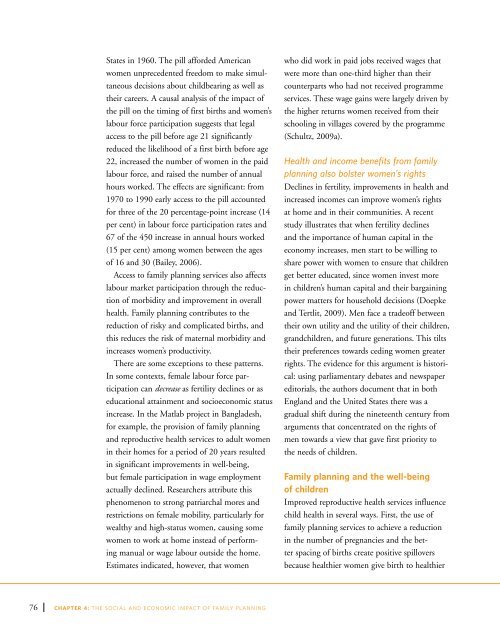State of World Population 2012 - Country Page List - UNFPA
State of World Population 2012 - Country Page List - UNFPA
State of World Population 2012 - Country Page List - UNFPA
You also want an ePaper? Increase the reach of your titles
YUMPU automatically turns print PDFs into web optimized ePapers that Google loves.
<strong>State</strong>s in 1960. The pill afforded American<br />
women unprecedented freedom to make simultaneous<br />
decisions about childbearing as well as<br />
their careers. A causal analysis <strong>of</strong> the impact <strong>of</strong><br />
the pill on the timing <strong>of</strong> first births and women’s<br />
labour force participation suggests that legal<br />
access to the pill before age 21 significantly<br />
reduced the likelihood <strong>of</strong> a first birth before age<br />
22, increased the number <strong>of</strong> women in the paid<br />
labour force, and raised the number <strong>of</strong> annual<br />
hours worked. The effects are significant: from<br />
1970 to 1990 early access to the pill accounted<br />
for three <strong>of</strong> the 20 percentage-point increase (14<br />
per cent) in labour force participation rates and<br />
67 <strong>of</strong> the 450 increase in annual hours worked<br />
(15 per cent) among women between the ages<br />
<strong>of</strong> 16 and 30 (Bailey, 2006).<br />
Access to family planning services also affects<br />
labour market participation through the reduction<br />
<strong>of</strong> morbidity and improvement in overall<br />
health. Family planning contributes to the<br />
reduction <strong>of</strong> risky and complicated births, and<br />
this reduces the risk <strong>of</strong> maternal morbidity and<br />
increases women’s productivity.<br />
There are some exceptions to these patterns.<br />
In some contexts, female labour force participation<br />
can decrease as fertility declines or as<br />
educational attainment and socioeconomic status<br />
increase. In the Matlab project in Bangladesh,<br />
for example, the provision <strong>of</strong> family planning<br />
and reproductive health services to adult women<br />
in their homes for a period <strong>of</strong> 20 years resulted<br />
in significant improvements in well-being,<br />
but female participation in wage employment<br />
actually declined. Researchers attribute this<br />
phenomenon to strong patriarchal mores and<br />
restrictions on female mobility, particularly for<br />
wealthy and high-status women, causing some<br />
women to work at home instead <strong>of</strong> performing<br />
manual or wage labour outside the home.<br />
Estimates indicated, however, that women<br />
who did work in paid jobs received wages that<br />
were more than one-third higher than their<br />
counterparts who had not received programme<br />
services. These wage gains were largely driven by<br />
the higher returns women received from their<br />
schooling in villages covered by the programme<br />
(Schultz, 2009a).<br />
Health and income benefits from family<br />
planning also bolster women’s rights<br />
Declines in fertility, improvements in health and<br />
increased incomes can improve women’s rights<br />
at home and in their communities. A recent<br />
study illustrates that when fertility declines<br />
and the importance <strong>of</strong> human capital in the<br />
economy increases, men start to be willing to<br />
share power with women to ensure that children<br />
get better educated, since women invest more<br />
in children’s human capital and their bargaining<br />
power matters for household decisions (Doepke<br />
and Tertlit, 2009). Men face a trade<strong>of</strong>f between<br />
their own utility and the utility <strong>of</strong> their children,<br />
grandchildren, and future generations. This tilts<br />
their preferences towards ceding women greater<br />
rights. The evidence for this argument is historical:<br />
using parliamentary debates and newspaper<br />
editorials, the authors document that in both<br />
England and the United <strong>State</strong>s there was a<br />
gradual shift during the nineteenth century from<br />
arguments that concentrated on the rights <strong>of</strong><br />
men towards a view that gave first priority to<br />
the needs <strong>of</strong> children.<br />
Family planning and the well-being<br />
<strong>of</strong> children<br />
Improved reproductive health services influence<br />
child health in several ways. First, the use <strong>of</strong><br />
family planning services to achieve a reduction<br />
in the number <strong>of</strong> pregnancies and the better<br />
spacing <strong>of</strong> births create positive spillovers<br />
because healthier women give birth to healthier<br />
76 CHAPTER 4: THE SOCIAL AND ECONOMIC IMPACT OF FAMILY PLANNING
















